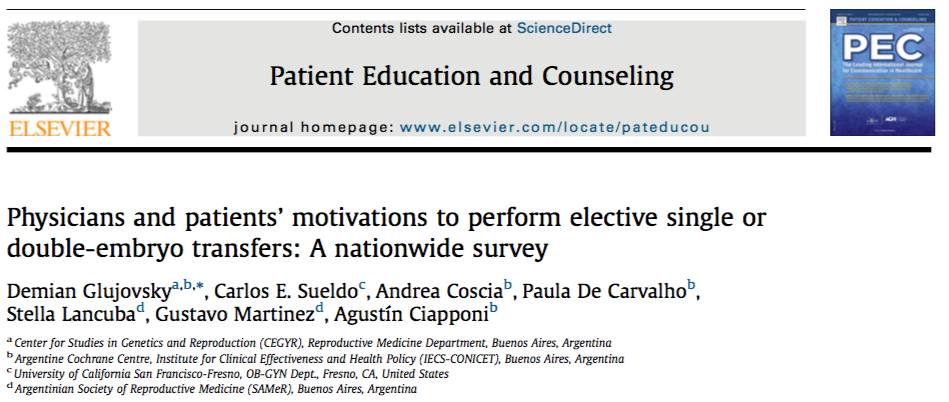E-SET: elective single embryo transfer
A few days ago we published a new study in a peer-reviewed journal entitled Patient Education and Counseling. It is a journal that publishes research on how to advise patients so they can understand the message properly and can choose what works best, based on their own values and preferences. In this case, the question was about embryo transfers: elective single embryo transfer (e-SET) or double embryo transfer (DET)?
Our study
Our paper was entitled Physicians and patients’ motivations to perform elective single or double-embryo transfers: A nationwide survey. We analyzed 2 surveys conducted to specialists in fertility in Argentina and to patients who were going to undergo an IVF cycle. It is interesting to take a look at the two points of view since decisions that will be made will depend on the participation of both.
What have we known until now?
Although the e-SET is more frequently performed now than in the past, it is still lower than expected. In USA, 21% of all embryo trasfers are e-SETs. Obviously, they are more frequent in women under 35, but even so, 2 out of 3 continue to transfer more than one embryo in that age group. As a result, more than 10% are multiple pregnancies (twins and triplets). I like to remind you that multiple pregnancies are associated with a higher chance of maternal complications (such as hypertension and gestational diabetes) and neonatal complications (mainly associated with preterm birth).
Survey to doctors
The first surprise was that only 24% of physicians offer e-SET to all their patients. Many offer it to some of them, but not to all. The surprise is that nowadays we expect that medical decisions are shared by doctors and patients. If physicians do not offer this option, that decision is not longer shared.
When we asked them why they did not offer it to all the patients, some said the following: many patients valued more positively the achievement of a pregnancy than negatively the potential complications of a multiple pregnancy; and others said that patients are frustrated with repetitive failures. By the way, both answers are logic … however, they do not explain that the decision is made only by the doctor instead of making a shared decision.
Anyway, awe should also say that there is a lack of didactic material to support this type of decisions which makes doctors spend a long time giving some tedious explanations. In fact, 93% thought that they would like to have new and better material designed to explain this to patients (named decision aid tools).
Doctors must take the time to explain in detail the advantages and disadvantages of each option so our patients can make the best possible decisions. Many would be surprised to see that the decisions that patients make do not agree with those that, a priori, the doctor would believe they would take. And, in addition, it would help reduce the complications of multiple pregnancy.
Survey to patients
Although more patients agree to have e-SET now than in the past, this decision is still taken by a minority, being that only 21% of the respondents preferred e-SET. In those cases, it was always on blastocyst stage.
The patients also responded that it was more frequent for the doctor to spend time talking about the effectiveness of the treatment than about its possible complications. It is interesting find that 30% of those patients who felt they had enough time to discuss with the doctor about how many embryos should be transferred, chose e-SET. On the other hand, among those who did not have time to discuss this topic, the e-SET was 0%.
Finally, this survey helped 10% of patients to think again about this. They mentioned, after the survey, they would like to think again about how many embryos they wanted to transfer. The fact of talking about the subject made them consider to change there mind about it.
Objective data and what we do
Cumulative pregnancy rates when doing e-SET and DET is similar. Moreover, some studies show that cumulative rates could be even higher in e-SET. Of course, complication rates are clearly higher in multiple pregnancies and, these increase proportionally to the number of embryos that are transferred. It’s fair to say that in case of e-SET, time-to-pregnancy is some longer than in DET.
Our team works to adequately inform our patients. I like that my patients have the same information as me so that they can participate actively in making decisions. Currently we transfer in blastocyst stage and most cases are e-SET. Of course, not in all cases (we are flexible according to each patient’s needs). I like that my patients choose.
Shared decisions: the key of a modern medicine. e-SET is a good example to understand the meaning of shared decisions … and a good exercise for the doctor in the democratization of his knowledge.



